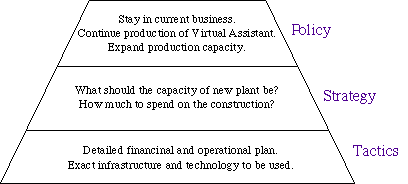
It is important to understand which questions are going to be addressed in the analysis - to define the scope of the decision problem at hand. Without explicit bounds it is easy to make the analysis unreasonably complicated. Blindly plunging into analysis may also result in a lot of effort and money wasted on working on the wrong problem.
The analysis begins with structuring or framing of the decision
problem. The purpose of the decision frame is to specify what is
under consideration and what is not. All possible decisions can divided
into three categories: policy, strategy and tactics.
Decision Hierarchy can be very useful for illustrating these three
levels.

Strategy level consists of questions that the analysis will concentrate on. The main question raised by the Board of Directors is "What expansion plan should we go for?" The two main considerations here are the additional capacity that the company will have and the amount of money the company will have to spend.
Tactics level consists of the decisions that will be made later, after
a specific strategy is chosen. All the operational and financial planning
will be done according to the strategy chosen and the infrastructure and
technology decisions will have to be made when the facilities are ready.
|
|
|